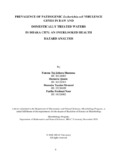Prevalence of pathogenic Escherichia coli virulence genes in raw and domestically treated waters in Dhaka city: An overlooked health hazard analysis
Abstract
Diarrhea is one of the leading causes of infant mortality in developing countries like Bangladesh. This
study aims to detect the presence of fecal coliform in the supplied water and treated water in the households of Dhaka city. The samples were collected from October 2018 till August 2019. The samples
were further subjected to PCR to detect the presence of diarrheagenic E.coli. Nine primer pairs were
used detect the five diarrheagenic strains of E.coli (EPEC, EHEC, ETEC, EAEC and EIEC). Fecal coliform counts produced by supplied water samples and treated water samples were categorized into the
following: 0 count, 1-5 count, 6-30 count, 31-100 count, >100 count. Fecal coliform was not detected
in 29.46% of the supplied water samples. On the other hand, 18.26% of the supplied water samples
produced a fecal coliform count of greater than 100. 12.86% of supplied water samples have a count
varying between 1 to 5, 27.81% of the samples have a 6 to 30 fecal coliform count and 11.62% of the
samples have 31 to 100 fecal coliform count. ETEC was detected in 14.94% of the samples while
EHEC was detected in 12.24% of the supplied water samples. 3.94% of the supplied water samples had
EAEC. EPEC and EIEC were detected in 1.45% of the supplied water samples only. 52.62% of the
treated water samples did not produce any fecal coliform count, while 1.65% of the treated water samples had a fecal coliform count greater than 100. 14.88%, 21.49% and 9.37% of the treated water samples had a fecal coliform count of 1-5, 6-30 and 31-100 respectively. ETEC, EHEC and EAEC were
detected in 3.03%, 2.75% and 0.83% of the treated water samples respectively. EPEC and EIEC were
not detected in the treated water samples.

